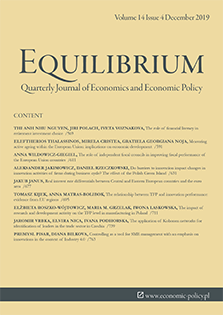Do barriers to innovation impact changes in innovation activities of firms during business cycle? The effect of the Polish green island
Do barriers to innovation impact changes in innovation activities of firms during business cycle? The effect of the Polish green island
Author(s): Aleksander Jakimowicz, Daniel RzeczkowskiSubject(s): Business Economy / Management, Energy and Environmental Studies, Economic history, Economic development
Published by: Instytut Badań Gospodarczych
Keywords: industrial processing enterprises; innovation strategy; barriers to innovation; ecoinnovations; business fluctuations;
Summary/Abstract: Research background: There is no doubt that innovation is an important source of economic growth. In the assessment of the innovative activity of Polish industrial processing enterprises, two opposing views can be found. The first indicates the exogenous shock resulting from the global financial crisis and the associated innovation crisis and the subsequent period of innovative pessimism. The second shows the Polish economy as the European Green Island due to strong and uninterrupted economic growth over the past 27 years, controlled inflation, and reduction of unemployment as well as increase of the citizens’ well-being. In these conditions, an interesting research gap appeared, which is worth filling, at the centre of which there are factors determining the innovative activity of enterprises, and in particular the role and importance of innovation barriers in various phases of the business cycle. Purpose of the article: The aim of the research is to determine the impact of innovation barriers and degrees of their importance on the innovation activity of Polish industrial processing enterprises during the business cycle. The time frame of the analysis covers three phases of the cycle: the prosperity period of 2004–2006, the global financial crisis of 2008–2010 and the recovery from 2012–2014. Methods: Pearson’s χ 2 independence test and correspondence analysis were used for data analysis. The research results are presented in a graphical form of biplots that describe the cooccurrence of three types of variables: (1) types of enterprises and ownership sectors, (2) effects or objectives of innovative activity, and (3) innovation barriers and reasons for the lack of innovation. The basis of calculations were three databases covering the mentioned periods. Findings & Value added: High resistance of innovative activity of Polish industrial processing enterprises to economic fluctuations has been demonstrated. Innovation barriers and degrees of their importance had little impact on the operations of enterprises in the first of the analysed periods, when prosperity was booming. The impact of the global financial crisis on innovation activities proved to be counterintuitive, as enterprises have continuously achieved their goals and the importance of innovation barriers has diminished even more. In the third period, innovation barriers no longer had any significance for the innovation activities of enterprises. The phenomenon of a gradual decline in the importance of innovation barriers, regardless of the phases of the business cycle, was called the Polish Green Island Effect. The relationship found is a peculiarity which is probably unprecedented in recent world economic history.
Journal: Equilibrium. Quarterly Journal of Economics and Economic Policy
- Issue Year: 14/2019
- Issue No: 4
- Page Range: 631-676
- Page Count: 46
- Language: English

